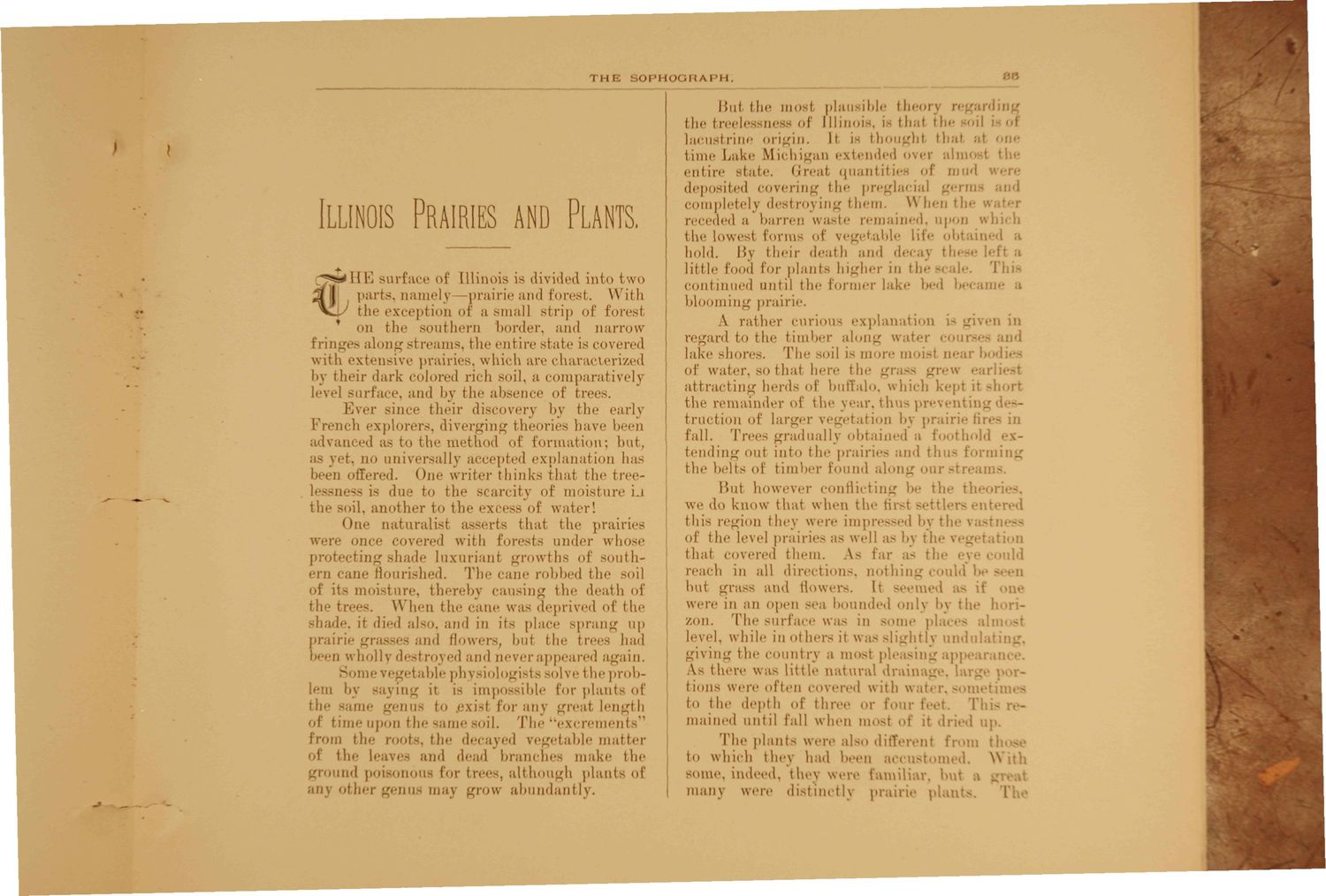| |
| |
Caption: Sophograph - 1891
This is a reduced-resolution page image for fast online browsing.

EXTRACTED TEXT FROM PAGE:
THI 'I'lKH.HAI'll, 00 D RAIRIES AND PLANTS. Ill-] surface of Illinois is divided into two parts, namely —prairie and forest. With the exception of a small strip of forest on the southern border, and narrov fringes along streams, the entire state is covered with extensive prairies, which are characterized by rheir dark colored rid) soil, a comparatively level surface, and by the absence of trees. Ever since their discovery by the early French explore)--, diverging theories have been advanced as to the method of formation: hut. as vet. no universally accepted explanation has been offered. One writer thinks that the tree[essness is due to the scarcity of moisture i.i the -nil. another to the excess of water! One naturalist asserts that the prairies were once covered with forests under whose protecting shade luxuriant growths of southern cane flourished. The cane robbed the -oil i ite moisture, thereby causing the death of the trees. \\ ben the cane was deprived of the ide, it died also, and in its place sprang up prairie grass ml flowers, but the trees had a wholly desi roj ed and never appeared again. Some vegetable physiologists solve the problem by Lying it is impossible for plants of the ime genus to exisi for any greai length f tine-upon the same soil. The "excrements" from the roots, the decayed vegetable matter f the leave and dead branch) make the und poisonous for trees, although plants of other ^'iius may <jrow abundantly. Bui t he mosi plausible 1 heoi < he t reelessness of fllinoi t hal t he lacustrine origin. It i tb» hi tl time hake Michigan extended over all tl entire state. Greai quantitie of mad wen deposited covering the preglacial 1 completely destroying them. W hen the w receded a IKOTC,'! waste remained, upon which the lowesi forms of vegetable life ob a hold. By their deaih and d 1 th • lei a < 3 little food for plants higher iu the le. Th conilimed until the Conner lake bed blooming prairie. A rather curious explanation is given ii regard to the timber along water cou am lake shores. The soil is more moisl near I of water, so that here the gr grew • attracting herds of buffalo, which kept it shor the remainder of the year, thus preventing destruction of larger vegetation by prairie fi fall. Trees gradually obtained a i tlndd extending "ut into the prairies and thus I »rming the belts of timber found along ourstrean But however conflicting be the tl we do know that when the first settlers entered this region they were impressed bj vasti is of the level prairies as well as by the veg n thai covered them. As far as the • • mid reach in all directions, nothing could be * .u but grass and flowers. It seemed as if on were in an open sea hounded only by the h -i/on. The surfa was in some pla tin level, while in ot her- it was slightly undulatii giving the country amostph dngapj As t here was lit t le nai ural drain t ions were o f t e n covered w i t h w at- r. - to t he dept h of three or I ir ! is mained until fall when mosi oi ii dried up. The plants were also differeni I nn to which t hey had been a < w ith Some, indeed, they were familiar, hut a ^ it many were distinctly praii plants. I.
| |